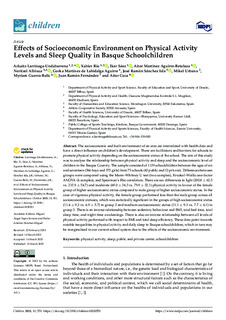Título
Effects of Socioeconomic Environment on Physical Activity Levels and Sleep Quality in Basque SchoolchildrenAutor-a
Autor-a (de otra institución)
Fecha de publicación
2023Otras instituciones
Universidad de DeustoMugikon
Athlon Koop E.
Universitat Ramon Llull
Kirolene: Kirol Irakaskuntzen Ikastetxe Publikoa
Universidad Euneiz
Versión
Version publicadaTipo de documento
ArtículoArtículoIdioma
InglésDerechos
© 2023 by the authors. Licensee MDPI, Basel, SwitzerlandAcceso
Acceso abiertoVersión de la editorial
https://doi.org/10.3390/children10030551Publicado en
Children vol. 10, issue 3, 551.Editorial
MDPIPalabras clave
Physical activitySleep
Public and private centre
Schoolchildren
Resumen
The socioeconomic and built environment of an area are interrelated with health data and
have a direct influence on children’s development. There are facilitators and barriers for schools to
promote ... [+]
The socioeconomic and built environment of an area are interrelated with health data and
have a direct influence on children’s development. There are facilitators and barriers for schools to
promote physical activity depending on the socioeconomic status of the school. The aim of this study
was to analyse the relationship between physical activity and sleep and the socioeconomic level of
children in the Basque Country. The sample consisted of 1139 schoolchildren between the ages of six
and seventeen (566 boys and 573 girls) from 75 schools (43 public and 32 private). Differences between
groups were compared using the Mann–Whitney U test (two samples), Kruskal–Wallis one-factor
ANOVA (k samples), and Spearman’s Rho correlation. There are sex differences in light (200.8 ± 62.5
vs. 215.9 ± 54.7) and moderate (69.0 ± 34.3 vs. 79.9 ± 32.1) physical activity in favour of the female
group of higher socioeconomic status compared to male group of higher socioeconomic status. In the
case of vigorous physical activity, the female group performed less than the male group across all
socioeconomic statuses, which was statistically significant in the groups of high socioeconomic status
(11.6 ± 9.3 vs. 6.9 ± 5.7) in group 2 and medium socioeconomic status (11.1 ± 9.3 vs. 7.7 ± 6.1) in
group 3. There is an inverse relationship between sedentary behaviour and BMI, total bed time, total
sleep time, and night-time awakenings. There is also an inverse relationship between all levels of
physical activity performed with respect to BMI and total sleep efficiency. These data point towards
notable inequalities in physical activity and daily sleep in Basque schoolchildren, which in turn may
be marginalised in our current school system due to the effects of the socioeconomic environment. [-]
Sponsorship
Basque Government, Department of Culture and Linguistic Policy, Department of Health and Department of EducationID Proyecto
K-09/2020Colecciones
- Artículos - Educación [124]
El ítem tiene asociados los siguientes ficheros de licencia:






















